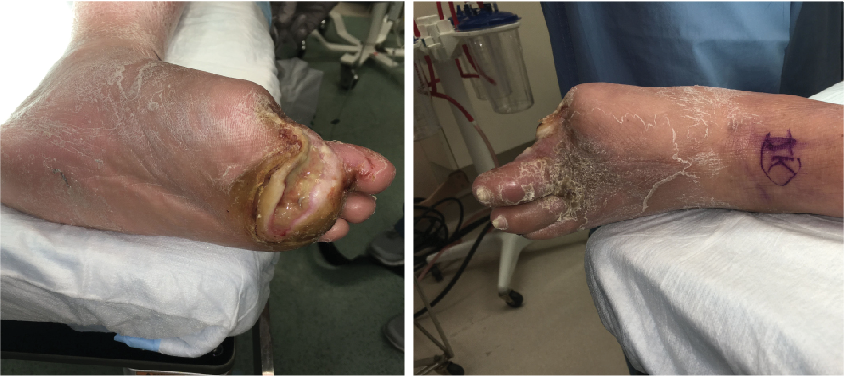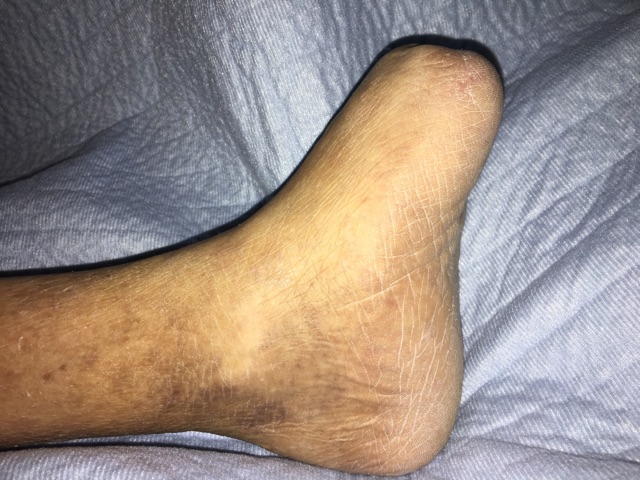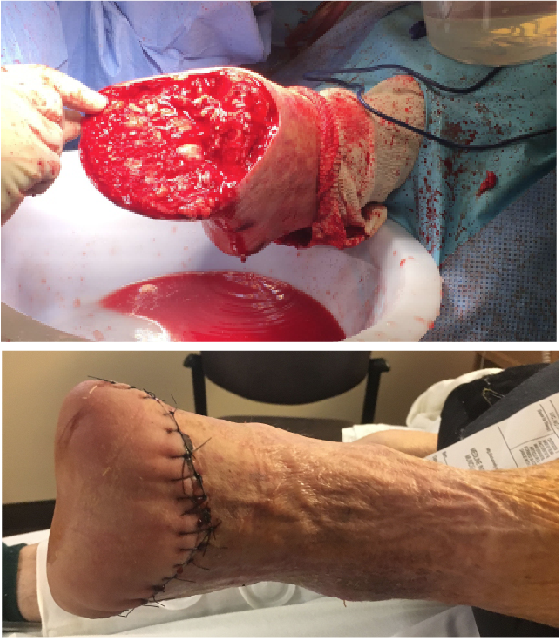ADVERTISEMENT
Transmetatarsal Amputation: Predictors Of Success And Failure
While transmetatarsal amputations can be a viable remedy for diabetic foot ulcers and other diabetic foot complications, there are variable healing rates and complication risks to consider. Accordingly, these authors discuss current indications, risk factors, key operative considerations, adjunctive tendon lengthening and balancing, and post-op management.
 Originally discussed in the literature by Bernard and Huete in 1855 for the treatment of trench foot, and subsequently employed by McKittrick in 1949 to address diabetic infections and gangrene, the transmetatarsal amputation (TMA) has evolved to treat a wider variety of pathologies.1,2 Surgeons now perform this procedure at varied metatarsal lengths based on the extent of the pathology. Some of the current indications for a TMA include but are not limited to ulceration, ischemia, failed toe or isolated ray amputations, frostbite, congenital deformities, trauma and tumors.2 Most commonly, TMAs occur in the setting of diabetic foot complications such as infection or chronic ulceration, gangrene and peripheral vascular disease.2,3
Originally discussed in the literature by Bernard and Huete in 1855 for the treatment of trench foot, and subsequently employed by McKittrick in 1949 to address diabetic infections and gangrene, the transmetatarsal amputation (TMA) has evolved to treat a wider variety of pathologies.1,2 Surgeons now perform this procedure at varied metatarsal lengths based on the extent of the pathology. Some of the current indications for a TMA include but are not limited to ulceration, ischemia, failed toe or isolated ray amputations, frostbite, congenital deformities, trauma and tumors.2 Most commonly, TMAs occur in the setting of diabetic foot complications such as infection or chronic ulceration, gangrene and peripheral vascular disease.2,3
The goals of TMAs are many but the ultimate goal is to achieve a stable plantigrade, shoeable foot that allows for ambulation while decreasing the risks of new or recurrent ulceration. Transmetatarsal amputations, though, are not without risk of complications and have variable reported healing rates. Healing rates for a TMA reportedly range from 40 to 70 percent.4 Reoperation rates after a TMA range from 8 to 63 percent and approximately one-third of TMAs will result in a major amputation.5 Despite the risk of complication and low healing rates of a TMA, the procedure remains the standard of care for the aforementioned indications.
Preoperative planning and evaluation, including a detailed evaluation of the patient, past medical history and lower extremity, is essential prior to selecting a TMA as a procedure. In addition, a surgeon must consider the patient’s goals and ambulatory status. Varying data exists on predictors of TMA outcome and no clear criteria has been defined for positive or negative predictors of TMA success.
In a retrospective review of 101 cases of TMAs investigating postoperative complications, researchers found that end-stage renal disease was a predictor of decreased healing and palpable pedal pulses were predictive of healing.3 Another retrospective review indicated that leukocytosis and end-stage renal disease were associated with non-healing amputations.6 This review did not find any clinical significance of diabetes or revascularization and healing rates.
 In a retrospective comparative study, Younger and colleagues found that hemoglobin A1c was the only risk factor to significantly predict the risk of failure of the amputation to heal.7 Smoking pack year history and increased length of duration of the ulcer trended toward being significant for failure to heal. They also found no significant difference in complications between patients with different vascular statuses (palpable pedal pulses, revascularized and non-palpable pulses). Another comparative study concluded that no amount of preoperative planning will guarantee success of a TMA because on a multivariate analysis, there were no associated preoperative measures that would predict healing of the amputation.8
In a retrospective comparative study, Younger and colleagues found that hemoglobin A1c was the only risk factor to significantly predict the risk of failure of the amputation to heal.7 Smoking pack year history and increased length of duration of the ulcer trended toward being significant for failure to heal. They also found no significant difference in complications between patients with different vascular statuses (palpable pedal pulses, revascularized and non-palpable pulses). Another comparative study concluded that no amount of preoperative planning will guarantee success of a TMA because on a multivariate analysis, there were no associated preoperative measures that would predict healing of the amputation.8
It is apparent in the literature that end-stage renal disease appears to be the only significant predictor of TMA failure. Varying results regarding diabetes control, vascular status and preoperative revascularization, and infection make it difficult to determine the risk factors associated with non-healing and complications associated with TMAs. Much of the research points to the judgment of the surgeons and their evaluation of the patient and optimization for a TMA.
Essential Surgical Considerations
Operative technique can contribute to the success of a TMA. This begins with timing of the TMA. It can either be emergent or delayed for patient optimization. More emergent situations are associated with severe diabetic or ischemic infections. In cases of infection, one should leave the TMA open to drain and treat these patients with the appropriate antibiotics and serial debridement. Trauma may also be associated with the need for an emergent TMA. In this situation, the extent of the damage to the structures of the foot would need a full evaluation to determine if a TMA is a viable option.
 In both the emergent and delayed settings, surgeons need to employ careful operative techniques during a TMA. The surgeon needs to handle the soft tissues, especially the skin, with care in an atraumatic technique. One can place a tourniquet but this may be contraindicated in patients with vascular compromise or those with recent revascularization. If the tourniquet is inflated, release it prior to closure to evaluate hemostasis and viability of the tissues.
In both the emergent and delayed settings, surgeons need to employ careful operative techniques during a TMA. The surgeon needs to handle the soft tissues, especially the skin, with care in an atraumatic technique. One can place a tourniquet but this may be contraindicated in patients with vascular compromise or those with recent revascularization. If the tourniquet is inflated, release it prior to closure to evaluate hemostasis and viability of the tissues.
The TMA begins with determining the level of amputation along the metatarsals. Generally, it is beneficial to maintain as much length of the metatarsals as possible while having adequate soft tissue coverage upon closure. After determining metatarsal length, mark the incision. Typically, one utilizes a fish mouth-shaped incision with a plantar flap that is longer than the dorsal flap to assist with soft tissue coverage. After making the incision, deepen it to the level of the bone to create full-thickness flaps.
One can remove the distal aspect of the foot and resect the metatarsals using a sagittal saw. Bevel the metatarsal cuts from dorsal distal to plantar proximal with the first and fifth metatarsals beveled medially and laterally respectively to avoid prominences. It is important to maintain the metatarsal parabola. After completing all bone cuts, transect the extensor and flexor tendons as proximal as possible, and remove the plantar plates and sesamoids. If no infection is present, complete closure with minimal skin tension to avoid necrosis.2
Can Flaps Have An Impact In Closing Soft Tissue Defects With TMAs?
There are certain situations that make it difficult to close a TMA. In settings of infection, leave the wound open and maintain local wound care until further debridement and closure are possible.2
Large plantar ulcerations can also lead to difficult closure of a TMA. A recent case series by Boffeli and Waverly discusses the use of medial and lateral plantar artery angiosome rotational flaps to close the soft tissue defects associated with TMAs.9 Surgeons can close TMAs with a lateral soft tissue defect with a medial plantar artery angiosome rotational flap while one can close medial soft tissue defects with lateral plantar artery angiosome flaps. Boffeli and Waverly also described combining the flaps to cover a large central defect.9 Canales and colleagues report a new closure method for TMAs in which one places drill holes in the first, second and fourth metatarsals to pass sutures through during closure.10 The authors found this approach added stability to the plantar flap of the amputation, promoting early weightbearing in a more secure surgical site.
 What The Literature Reveals About Adjunctive Tendon Lengthening And Balancing
What The Literature Reveals About Adjunctive Tendon Lengthening And Balancing
Another method to optimize results is to complete tendon balancing procedures in addition to the TMA. An equinovarus deformity commonly arises after a midfoot amputation due to the reduced length of the foot and the gastrocnemius soleus complex overpowering the remaining muscle insertions and the varus rotation of the foot due to the loss of the metatarsal heads. This deformity leads to pressure on the plantar lateral stump of the TMA site, often causing ulceration. The equinus deformity can easily progress unaddressed due to the loss of the insertion of many of the anterior compartment muscle groups, thus allowing the posterior compartment muscle groups to have a greater effect in the foot. The varus deformity can also worsen due to the loss of the intrinsic musculature and loss of the plantar fascia insertion, causing an imbalance with increased pull of the tibialis anterior muscle.11
Lengthening of the Achilles tendon theoretically aids in reducing the lateral plantar pressures associated with TMAs. However, there is very little literature regarding Achilles lengthening (TAL) procedures in the setting of a TMA.
In 1993, Barry and colleagues performed 33 tendon Achilles lengthening procedures to address recurrent ulcerations in 31 patients who had TMAs.12 They found the healing rate to be 91 percent and did not report any recurrent ulcerations at 27 months. LaFontaine and coworkers reviewed the incidence of recurrent and new ulcerations in patients who had TMAs after a percutaneous TAL.13 They found a high rate of recurrence and new ulcers after performing the TAL in these patients with TMAs, and concluded that one needs to evaluate and address additional intrinsic or extrinsic factors.
Maluf and coworkers studied the effects of tendo-Achilles lengthening on plantar pressures while patients were ambulating.14 They noted initial reduction of forefoot pressures after the procedure but this was temporary. The forefoot pressures increased during an eight-month follow-up as the Achilles tendon regained strength. This could explain the initial healing of the amputation and associated ulcers along with the recurrence or new ulceration later. However, the authors discuss that the TAL is beneficial for offloading the forefoot initially to aid in healing of a forefoot ulcer. Accordingly, one could consider this for patients who have a TMA.
 Researchers have described other tendon balancing procedures to help balance the TMA deformity. Split tibialis anterior tendon transfer, a peroneus brevis to longus tendon transfer and flexor hallucis longus and extensor digitorum longus tendon transfers are some of the more common options. The literature has shown that a split tibialis anterior tendon transfer is effective in addressing forefoot varus deformity after midfoot amputations.11
Researchers have described other tendon balancing procedures to help balance the TMA deformity. Split tibialis anterior tendon transfer, a peroneus brevis to longus tendon transfer and flexor hallucis longus and extensor digitorum longus tendon transfers are some of the more common options. The literature has shown that a split tibialis anterior tendon transfer is effective in addressing forefoot varus deformity after midfoot amputations.11
Peroneus brevis to peroneus longus tendon transfers can plantarflex the first ray, evert the forefoot and also correct the forefoot varus deformity in a TMA. Both the tibialis anterior tendon transfer and peroneus brevis to longus transfers may be less desirable due to the additional incisions needed for the tendon transfer. These incisions may be contraindicated in patients with recent bypass procedures, those with peripheral vascular disease who would need to heal another incision.11
A technique report by Roukis discusses transferring the flexor hallucis to the residual first metatarsal and the extensor digitorum longus to the residual fourth metatarsal to reduce the forefoot varus.15 One corrects the varus through plantarflexion and eversion of the medial column, and eversion of the lateral column. This procedure, along with a percutaneous tendo-Achilles lengthening, can effectively balance the foot without the need for additional incisions, which is often advantageous for those patients who undergo a TMA.
What You Should Know About Post-Op Management
Postoperative management is imperative to healing of the TMA. Patient adherence is important in the postoperative course to increase the success rate of the TMA healing. Patients should have proper offloading whether they have partial weightbearing to the heel or are non-weightbearing with an assistive device. Close follow up is important to evaluate healing, signs of infection or dehiscence. Common complications arising in the postoperative period include skin breakdown and instability. Physical therapy can assist patients with the adjustment to the amputated foot.2
The surgeon must consider the functional impact the TMA has on a patient. The foot is shortened, gait velocity is reduced, ankle moments are reduced and midfoot pressures have increased. It is imperative to address these changes in the postoperative course to maximize healing and decrease the risk of new ulcers or reulceration. Inserts, shoes and bracing can aid in addressing post-TMA mobility for the patient.4
Mueller found that custom-made shoes and insoles have decreased plantar pressures in comparison to patients who have regular shoes with toe fillers.16 Stiff rocker bottom-soled shoes or carbon fiber plates were also associated with improved physical performance and walking speeds in patients with TMAs. Patients also can benefit from proper education regarding custom shoe gear after a TMA as custom shoes can distribute the weight evenly and decrease plantar pressures.
In Conclusion
A TMA is an adequate procedure to consider in the setting of non-healing ulcerations, infection, peripheral vascular disease and trauma, but the procedure is not without significant risk. A full evaluation of the patient, comorbidities and functional status can contribute to the surgical decision making process. Although the failure rate for a TMA is high, it is still a viable option as a limb salvage technique.
Dr. Iosue is a Clinical Fellow in Surgery at Harvard Medical School and a second-year resident at the Beth Israel Deaconess Medical Center in Boston.
Dr. Rosenblum is an Assistant Clinical Professor of Surgery at Harvard Medical School and the Associate Chief of the Division of Podiatric Medicine and Surgery at the Beth Israel Deaconess Medical Center in Boston.
References
- McKittrick LS, McKittrick JB, Risley TS. Transmetatarsal amputation for infection or gangrene in patients with diabetes mellitus. Ann Surg. 1949; 130(4):826.
- Wallace GF, Stapleton JJ. Transmetatarsal amputations. Clin Podiatr Med Surg. 2005; 22(3):365-384.
- Pollard J, Hamilton GA, Rush SM, Ford LA. Mortality and morbidity after transmetatarsal amputation: retrospective review of 101 cases. J Foot Ankle Surg. 2006; 45(2):91-97.
- Ammendola M, Sacco R, Butrico L, et al. The care of transmetatarsal amputation in diabetic foot gangrene. Int Wound J. 2007; 14(1):9-15.
- Thorud JC, Jupiter DC, Lorenzana J, et al. Reoperation and reamputation after transmetatarsal amputation: a systematic review and meta-analysis. J Foot Ankle Surg. 2016; 55(5):1007-1012.
- Blume P, Salonga C, Garbalosa J, et al. Predictors for the healing of transmetatarsal amputations: retrospective study of 91 amputations. Vascular. 2007; 15(3):126-133.
- Younger ASE, Awwad MA, Kalla TP, de Vries G. Risk factors for failure of transmetatarsal amputation in diabetic patients: a cohort study. Foot Ankle Int. 2009; 30(12):1177-1182.
- Landry GJ, Silverman DA, Liem TK, et al. Predictors of healing and functional outcome following transmetatarsal amputations. Arch Surg. 2011; 146(9):1005-1009.
- Boffeli TJ, Waverley BJ. Medial and lateral plantar artery angiosome rotational flaps for transmetatarsal and Lisfranc amputation in patients with compromised plantar tissue. J Foot Ankle Surg. 2016; 55(2):351-361.
- Canales MB, Heurich ME, Mandela AM, Razzante MC. An approach to transmetatarsal amputation to encourage immediate weightbearing in diabetic patients. J Foot Ankle Surg. 2017; 56(3):609-612.
- Schweinberger MH, Roukis TS. Soft-tissue and osseous techniques to balance forefoot and midfoot amputations. Clin Podiatr Med Surg. 2008; 25(4):623-639.
- Barry DC, Sabacinski KA, Habershaw GM, et al. Tendo Achilles procedures for chronic ulcerations in diabetic patients with transmetatarsal amputations. J Am Podiatr Med Assoc. 1993; 83(2):96-100.
- La Fontaine J, Brown D, Adams M, Van Pelt M. New and recurrent ulcerations after percutaneous Achilles tendon lengthening in transmetatarsal amputation. J Foot Ankle Surg. 2008; 47(3):225-229.
- Maluf KS, Mueller MJ, Strube MJ, et al. Tendon Achilles lengthening for the treatment of neuropathic ulcers causes a temporary reduction in forefoot pressure associated with changes in plantar flexor power rather than ankle motion during gait. J Biomech. 2004; 37(6):897-906.
- Roukis TS. Flexor hallucis longus and extensor digitorum longus tendon transfers for balancing the foot following transmetatarsal amputation. J Foot Ankle Surg. 2009; 48(3):398-401.
- Mueller MJ, Strube MJ, Allen BT. Therapeutic footwear can reduce plantar pressures in patients with diabetes and transmetatarsal amputation. Diabetes Care. 1997; 20(4):637-641.
For further reading, see “A Closer Look At Preserving Foot Function With A Transmetatarsal Amputation” in the December 2015 issue of Podiatry Today.











